Top News
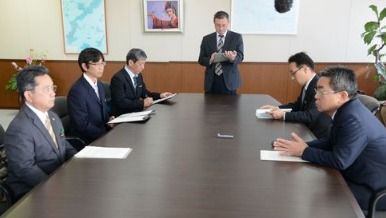
February 16, 2018 Ryukyu Shimpo
On February 15, Okinawa Prefectural Board of Education Superintendent Shojin Heshiki met with Ministry of Defense Okinawa Defense Bureau (OBD) Director Kouichiro Nakajima. Superintendent Heshiki verbally requested for the U.S. military to suspend flight over all K-12 school and special support education schools in the prefecture.
Following the U.S. military helicopter accident last December in which a window from the helicopter crashed into the school grounds of the Futenma Daini Elementary School, Superintendent Heshiki identified this as a problem.
As a representative of the Okinawa Prefectural Board of Education, he decided to make an unprecedented request by asking the U.S. military to change their operations.
He said, “From the standpoint of protecting the lives of students, there is no way we cannot raise the topic of the Futenma Daini Elementary School accident.”
In his request to Director Nakajima, Superintendent Heshiki said, “I feel that the U.S. military aircrafts suspending their flights over school facilities is the general direction we should be taking.”
He then said, “I’m sure the national government is also working with the U.S. military, but we want them to focus on various options for their flight routes to ensure a safe environment.”
He also asked that the U.S. military aircrafts prevent noise in March and April when high school entrance examinations, graduation ceremonies, and entrance ceremonies are held.
In response to the request, Director Nakajima explained the OBD’s stance regarding the suspension of flights by U.S. military aircrafts over schools.
He said, “The Futenma Daini Elementary School accident should not have happened. We are asking U.S. military aircrafts to not fly over educational institutions.”
With that, he also emphasized that “We too want to do everything we can to ensure a safe environment as much as we can. He thereby sought people’s understanding.Regarding the suspension of flights during high school entrance examinations and graduation ceremonies, Director Nakajima said, “Every year, we update the U.S military on the dates. Especially with entrance exams, they determine a young person’s future, so we have requested that they take that into consideration.”
The request was also reported to the board of education members during a study session prior to the Prefectural Board of Education regular meeting held on February 15.
(English translation by T&CT and Chelsea Ashimine)
Go to Japanese
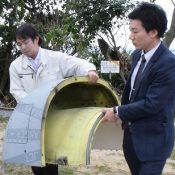
February 16, 2018 Ryukyu Shimpo
Tokyo – Japanese Minister of Defense Itsunori Onodera spoke at a press conference concerning the accident wherein an engine intake falling from an MV-22 Osprey February 16.
Regarding the issue of the late notification from the U.S., he commented that, “The III Marine Expeditionary Force (III MEF) was not quick in notifying U.S. Forces Japan central command,” indicating that the cause of the late notification was due to late internal communication by the U.S. military.
It appears there was also no apology.
Notification of accidents is outlined in detail in the U.S. Japan Status of Forces Agreement (SOFA).
The failure to properly communicate within even the U.S. military would appear to be in violation of the agreement.
According to Onodera, the III MEF, which is transported by the Osprey, “fully understand that when an incident such as this on occurs, it is necessary to notify U.S. central command.”
He also explained, “Furthermore, the U.S. military will continue to improve on their methods for notifying and sharing information with the Japanese government.”
The Minister of Defense requested that he be notified immediately.
Regarding the late notification, Onodera concluded, “The fact that they said they would continue to improve on their end shows they acknowledge that up until now it has been insufficient.”
(English translation by T&CT and Sam Grieb)
Go to Japanese
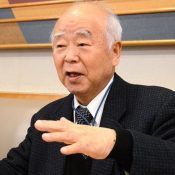
February 11, 2018 Ryukyu Shimpo
Former Minister of Defense Fumio Kyuma, who was also the director-general of the Defense Agency at the time of the Special Action Committee on Okinawa (SACO) final report and when the agreement to build on the shore on Camp Schwab was made, had an interview with Ryukyu Shimpo as of February 8 concerning the the return of Futenma Air Station.
He showed doubt regarding the necessity of the base, asking in the interview: “Do they need bases in Henoko or Futenma? Are they unnecessary?”
Kyuma’s remarks show doubt about the necessity of the bases due to the present advanced state of military technology.
This is extremely unusual coming from someone involved in furthering construction of the new base.
In 2012 Satoshi Morimoto, who was minister of defense at the time, said in regards to the relocation of Futenma Air Station, “Militarily, the relocation of Futenma doesn’t need to be in Okinawa, but politically, Okinawa is the most appropriate place.”
Also, cabinet ministers have been increasingly giving political reasons for forcing bases on Okinawa.
Kyuma’s remark reinforces the appearance that the reasons are political, which could make waves.
Kyuma notes that military technology is improving, missile defense posture is intensifying, and defense equipment such as unmanned attack aircraft is becoming more advanced.
With this in mind, he commented: “Do they need bases in Henoko or Futenma?
Are they unnecessary?
Even aside from this discussion, security is changing.”
Furthermore, Kyuma expressed his reservations about the size of the airfield being constructed, saying, “They don’t need an airfield that expansive.”
In terms of currently increased level of consideration for Japan having autonomous defense capabilities, Kyuma pointed out that in regards to the Treaty of Mutual Cooperation and Security between the U.S. and Japan, “there is an opportunity coming to reflect on things from [the treaty’s] allotted roles to its substance.”
He also claimed that the U.S.-Japan Status of Forces Agreement (SOFA) should be revised.
While voicing his objection to the presence of the Marine Corps in Okinawa, Kyuma implied that Okinawa is worse off than a hostage.
His opinion is that the number of personnel stationed there should be fixed.
He also showed understanding for the current plan for a new base in Henoko.
However, regarding the reason that the method of land reclamation was decided upon for the new base, he confirmed that the Defense Agency (currently the Ministry of Defense) hypothesized attacks from outside.
At the time, Prime Minister Ryutaro Hashimoto was considering the potential mega-float project to withdraw the Marines, but the Ministry of Defense presented a plan to settle the bases in Okinawa.
Kyuma was the director-general of the Defense Agency from November 1996 to July 1998, again from September 2006 to January 2007, and worked as the first Minister of Defense from January 2007 until July 2007.
(English Translation by T&CT and Erin Jones)
Go to Japanese
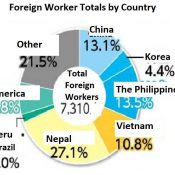
February 9, 2018 Ryukyu Shimpo
On February 8, the Okinawa Labor Bureau announced that the number of foreign workers in Okinawa Prefecture reached a record high of 7,310 people (as of October 2017), an increase of 1,339 (22.4%) from the same month the previous year.
The countries from which the most foreign workers came were Nepal at 1,981 people (27.1%), the Philippines at 986 people (13.5%), and China including Hong Kong at 955 people (13.1%).
There are 1,445 companies employing foreign workers.
According to their statuses of residence, 2,436 people are students, 1,840 people are workers in skilled and engineering fields, and 926 people are technical interns.
The industry employing the most foreign workers is the accommodation and food service industry with 1,198 people.
There are 1,018 foreign workers in the wholesale and retailing industry, and 609 people work in the construction industry.
As of October each year, foreign workers in Okinawa numbered 3,388 in 2014, 4,898 in 2015, and 5,971 in 2016.
This number increases every year.
Among these workers, the number of people from Nepal has been growing every year, with 561 in 2014, 1,464 in 2015, and 1,610 in 2016.
In 2015, the workers from Nepal surpassed the number of those from China, which was the highest in the previous year.
(English translation by T&CT and Megumi Chibana)
Go to Japanese

February 12, 2018 Ryukyu Shimpo
By Special Correspondent Lima Tokumori
The 6th World Youth Uchinanchu Festival (hosted by the festival’s executive committee) held the round table discussion, closing ceremony, and grand finale February 10 at the Peru Okinawa Kenjin-Kai Hall in the suburbs of Lima, Peru, ending the five day festival.
Okinawan descendants from all over the world from their teens into their 30’s exchanged hugs and promised to see each other again.
At the grand finale, the band HY from Uruma City performed to great excitement from the crowd.
The next festival is planned for 2020, although the location is yet to be determined.
At the closing ceremony, Karina Vallejos Kohatsu, vice-president of the festival committee, gave her closing remarks, stating, “Even though we come from different backgrounds and nationalities, we have the same Uchinanchu roots.
I believe that our efforts to spread Okinawan culture will form a bond for generations to come.”
During the dinner, festival-goers were able to dine of Peruvian cuisine and enjoy traditional dance performed by the Peru Kitanakagusuku Sonjinkai.
Peruvian-born Kenji Igei Kohatsu, 30, also performed the festival’s theme song, “Shima Ganasa Uchina” to thunderous applause.
For the grand finale, the band HY, who traveled from Okinawa for the festival, took the stage.
The band greeted the festival, saying, “To all the Uchinanchu who have gathered from all over the world: Haisai!” (Okinawan for hello).
The band played a song re-written in Spanish, allowing the audience to sing along.
Hideyuki Shinzato (guitar, vocals) exclaimed, “I am happy that our music was able to bring us to Peru.
Because all of their ancestors left Okinawa and did their best, everyone was able to connect again here.
” The night concluded with everyone putting their arms around each other’s shoulders and singing.
Mariela Koya, 30, who traveled from Argentina, said “My grandparents died before I was born. At this festival, I learned about the Battle of Okinawa, and I feel like I was able to learn about their thoughts and struggles.”
Rina Tamaki, 29, who traveled to the festival from Okinawa, commented, “I am happy people were able to interact with the Nago City Social Organization. There were many people here who said they wanted learning materials about Okinawa’s history. I want to do what I can to help them when I go back to Okinawa.”
(English translation by T&CT and Sam Grieb)
Go to Japanese
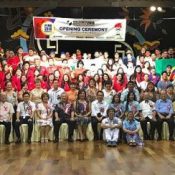
February 8, 2018 Ryukyu Shimpo
By Peruvian Correspondent Mitsuhiro Akamine
The Sixth World Youth Uchinanchu Festival commenced in the evening on February 6 local time in Lima, Peru (Japan time February 7).
The festival attracts young people of Okinawan descent from all over the world.
The opening ceremony was held at the Peruvian Okinawan Hall on the outskirts of Lima.
More than 100 people of Okinawan descent ranging from teens to thirties from around the world participated.
Executive Committee Chairman Minami Tamamoto gave a powerful greeting.
She said, “In an effort to construct and expand the youth Uchinanchu global network around the world, we will strengthen our identity as Uchinanchu.
We will embrace our history of emigration and pass it on.”
The First World Youth Uchinanchu Festival was held in Brazil, making this the second time in which the festival was held in South America.
During the ceremony, Executive Committee Vice Chairman Carina Kohatsu, a local resident of Peru, gave an enthusiastic speech.
She said, “As a leader of society for future generations of Okinawan descent, we will foster human resources, utilize the facilities in the Okinawan Hall.
We will strive to exchange culture and performing arts with sports and etc.”
Okinawan Association of Peru President Maria Luisa Kohatsu and Nikkei Association President Jorge Kunigami also spoke to the crowd.
Following the ceremony, a welcome dinner was held. The youth performed rock and jazz and ended with Kachashi, an Okinawan folk dance.
The participants greatly enjoyed the dinner in midsummer Peru.
The festival was held for five days between February 6 and 10.
It was primarily held at the Okinawan Hall, but also took place at the Japanese Peruvian Hall and Cañete.
People deepened their exchange via mixers by municipalities, study tours to learn about the history of emigration, workshops, and symposiums on networking.
Besides the 25 people from Okinawa, 13 Argentinians, one Bolivian, three Brazilians, four Americans, two Canadians, 73 Peruvians, a total of 117 participated.
(English translation by T&CT and Chelsea Ashimine)
Go to Japanese
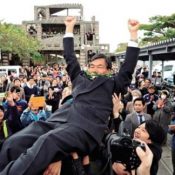
February 8, 2018 Ryukyu Shimpo
On February 7, a party to celebrate the end of Inamine’s term as mayor was held at the Nago City Office.
In his farewell address Inamine said, “The only regret weighing on my mind is the work I left unfinished. That is the issue of Henoko relocation. I made the judgement that new base construction is all harm for no gain, and I have complete consistency in thinking that we must not allow the new base to be built for the future of our children and for Nago City.”
With these words Inamine swore to remain involved in the Henoko issue as a concerned citizen.
Over 400 citizens came to the City Office and rushed up to Inamine to see him off after his two terms and eight years as mayor.
Flushed red with tears in their eyes, the Nago residents thanked Inamine for his troubles.
Leaving the City Office behind them, the smiling Nago residents lifted Inamine up above their heads four times, moving him with them on their way.
Deputy Mayor Masao Yamazato and Superintendent of Education Noriko Zamami also stepped down from their posts the same day.
Inamine said of the base problem, “Over the course of the last 20 years city residents have been at the mercy of national policy. Why are citizens of such a small town requesting national policy decisions? My heart is pained wondering how long this might go on.”
At times he choked on his words while speaking about the distress he felt day-to-day.
Citizens who rushed to see Inamine at his farewell party overflowed outside the City Office doors. Citizens rushed up in succession to tearfully share their words of gratitude with Inamine.
They said things such as: “Thanks to you we could live with peace of mind,” and “Thank you for your troubles, we won’t forget you.”
They also gave Inamine flowers.
A 29-year-old student who voted for Inamine for mayor commended Inamine’s approach in continuing to call for a halt to base construction as a concerned citizen. She said, “I hope you keep doing your best.”
(English translation by T&CT and Erin Jones)
Go to Japanese
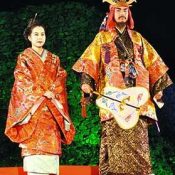
February 7, 2018 Ryukyu Shimpo
A thirty-eight year-old Genki Taguchi and twenty-five year-old Nozomi Uema have been chosen to be the sixth-generation Hokuzan king and queen, who will promote Nakijin village.
The unveiling ceremony for the king and queen was conducted at the eleventh Nakijin Gusuku Cherry Blossom Festival on January 27.
Taguchi commented, “I would like to promote appealing points of Nakijin village as the king of Hokuzan through the year,” while Uema also shared her ambition, saying, “I will try my best to promote Nakijin.”
The king and queen will appear in photography events on February 11 and 12, as well as other various events to promote Nakijin.
The Nakijin Gusuku Cherry Blossom Festival will be held until February 12.
(English translation by T&CT and Sayaka Sakuma)
Go to Japanese

February 1, 2018 Ryukyu Shimpo
The Okinawa Churaumi Aquarium in Motobu announced on January 30 that a male Alfred manta born at the aquarium in June, 2008 was confirmed to be an adult capable of reproduction at five years of age after having been continusouly observed since birth.
This is the first such finding made in the world.
According to the aquarium, wild mantas have been observed to become adults at five to six years old, yet it had never been officially confirmed.
The study observed over a long period of time the changes in the aquarium-born manta’s hormones, reproductive organs, and behaviors. The study demonstrated the manta reached its sexual maturity at approximately five years old.
This research, made possible by the long-term habitation in the aquarium, will be valuable in the conservation effort for the Alfred manta, which is threatened by population decline.
Aquarium manager Keiichi Sato, 46, commented at the presentation of the study’s findings, “This study provides data that can be utilized to study how to conserve the manta species.
This will also enable us to further work on captive breeding of the species.”
The male sample that reached its maturity had been growing well in a live-box in the ocean, and it is also confirmed that the manta mated with a female manta.
The study was publised by the international academic journal BMC Zoology, in October, 2017.
The Alfred manta is the biggest species among manta rays.
They live mainly around temperate and tropical marine waters such as the southern Okinawa and the Indo-Pacific Oceans.
(English translation by T&CT and Sayaka Sakuma)
Go to Japanese
February 5, 2018 Ryukyu Shimpo
The issue of MCAS Futenma’s relocation to Henoko, Nago City was the major issue at hand in the Nago mayoral election. Taketoyo Toguchi, an independent new candidate endorsed by the Japanese government which is advancing construction in Henoko, beat the independent incumbent who calls for a halt to construction, Susumu Inamine.
It would be hasty to conclude that Toguchi being elected translates to Nago City residents approving of new base construction. That is because Toguchi has not declared his approval of construction, and only made known his approach will be to engage in discussions with the Japanese government in order to resolve the issue.
On February 2 at a meeting of the House of Representatives Budget Committee, Prime Minister Shinzo Abe said, “We are unable to gain understanding from the mainland for making it the relocation site.” This is the first time the prime minister has admitted a political reason rather than a military reason for MCAS Futenma being relocated within Okinawa. For a politician, this is an irresponsibly discriminatory statement to make toward Okinawa. Toguchi’s election must not result in an impossibility of relocating MCAS Futenma to another prefecture and the forcing of the new base upon Nago City.
The newly elected Toguchi said of the relocation to Nago, “There is ongoing contention between the country and the prefecture, so I will keep close watch [on the situation].” It is a stretch to presume he will accept the new base.
For one example, before the Nago mayoral election, the Ryukyu Shimpo conducted a telephone public opinion poll, which showed that Nago residents’ attitudes are clear. In regard to the plan to relocate MCAS Futenma to Henoko, Nago, 53.0 percent answered that they “oppose” it, and 13.0 percent said they “somewhat oppose” it, accounting for 66.0 percent against the plan. On the other hand, 10.5 percent responded that they “support” it, and 17.8 percent said they “somewhat support” it, which does not even reach 30 percent in favor of the plan.
By avoiding the topic of new base construction and highlighting economics, and gaining an endorsement from Komeito which had decided on autonomous voting for the previous election, it can be said that Toguchi’s election strategy was successful.
Toguchi said that he will “keep an eye on trials between Japan and Okinawa.” He also mentioned that, “Former Mayor Tateo Kishimoto accepted relocation to Henoko. I supported and approved of that.”
At the time when Kishimoto accepted relocation, he also presented seven conditions to curb effects on residents’ lives and the natural environment. These conditions included (1) the implementation of environmental impact assessments, (2) improvement of the U.S.-Japan Status of Forces Agreement (SOFA) and a 15-year limit to operations of the Futenma replacement facility, and (3) the conclusion of agreements on the use of bases. He declared that if these conditions were not satisfied, he would “revoke his approval of relocation.” The conditions put forth by Kishimoto have not been satisfied. Toguchi should bear this in mind.
However, the Okinawa branch of Komeito, which is calling for relocation of Futenma to outside Okinawa or outside Japan, endorsed the same candidate endorsed by the LDP, Toguchi. Head of Komeito’s Okinawa branch Tsutomu Kinjo gave the reason for having concluded a policy agreement with Toguchi; “We came to a mutual understanding as we want revision of the SOFA, and the Marine Corps to be moved out of Okinawa or out of Japan.” But if that comes to be, the new base for use by the Marine Corps will be unnecessary, will it not?
The issues facing Nago City are not limited to the new base problem; revitalizing the economy and promoting employment are major. It is essential that we quickly move to establish a flagship hospital. There are also pressing matters such as welfare, education, and population decline. Hopefully we steadily address these issues.
Translator’s note: “Autonomous voting” in this case refers to when a political party does not choose a candidate to endorse for an election, leaving their party members unguided in terms of candidate choice.
(English translation by T&CT and Erin Jones)
Go To Japanese
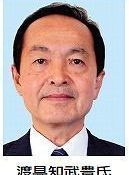
February 4, 2018 Ryukyu Shimpo Digital Edition
The Nago City mayoral election, which has become a major battleground in the ongoing dispute over the relocation of MCAS Futenma to Henoko, went to the polls on February 4. Newcomer Taketoyo Toguchi 56, won the election with 20,389 votes. Toguchi ran as an independent, but had the endorsement of the federal government’s ruling coalition of the Liberal Democratic Party (LDP) and Komeito, as well as the Japan Innovation Party (JIP), for his pro-base relocation stance. Incumbent Susumu Inamine 72, who also ran as an independent but had endorsements from the Social Democratic Party (SDP), Japanese Communist Party (JCP), Okinawa Social Mass Party (OSMP), Liberal Party (LP), and Democratic Party (DP), lost the election by 3,458 votes, coming in at a final tally of 16,931.
This is the first time in eight years that Nago will have a mayor that does not oppose the base relocation. The Henoko relocation being progressed by the Japanese and U.S. governments will now certainly pick up pace, and comes as a big blow to the influence of the “All Okinawa” faction looking to stop the relocation led by Governor Takeshi Onaga, who now sets their sights on the gubernatorial election in the fall.
(English translation by T&CT and Sam Grieb)
Go To Japanese










 Webcam(Kokusai Street)
Webcam(Kokusai Street)


